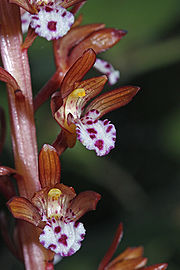
Corallorrhiza maculata
Encyclopedia
Corallorhiza maculata, or spotted coralroot, is a North America
n coralroot orchid flower. Varieties are also known as western coralroot and summer coralroot. It is found from Mexico
and Baja California
, through California
and most of the United States except the Southeast, and across Canada
. It grows mostly in montane
woodlands.
 This orchid is a myco-heterotroph; it lacks chlorophyll
This orchid is a myco-heterotroph; it lacks chlorophyll
and gets food by parasitizing the mycelium
of fungi in the family Russulaceae
. The rhizome and lower stem are often knotted into branched coral
shapes. The stem is usually red or brown in color, but occasionally comes in a light yellow or cream color. There are no leaves and no photosynthetic green tissues. The stalklike stems bear dark red scales and intricate orchid flowers.
The Corallorhiza maculata flowers are small and emerge regularly from all sides of the stem. The sepal
s are dark red or brown tinged with purple, long and pointed. The side petals are reddish, and the lip petal is bright clean white with deep red spots. It is usually lobed or toothed on the side and 7–10 mm. In some varieties, the lip is plain white without spots.
North America
North America is a continent wholly within the Northern Hemisphere and almost wholly within the Western Hemisphere. It is also considered a northern subcontinent of the Americas...
n coralroot orchid flower. Varieties are also known as western coralroot and summer coralroot. It is found from Mexico
Mexico
The United Mexican States , commonly known as Mexico , is a federal constitutional republic in North America. It is bordered on the north by the United States; on the south and west by the Pacific Ocean; on the southeast by Guatemala, Belize, and the Caribbean Sea; and on the east by the Gulf of...
and Baja California
Baja California
Baja California officially Estado Libre y Soberano de Baja California is one of the 31 states which, with the Federal District, comprise the 32 Federal Entities of Mexico. It is both the northernmost and westernmost state of Mexico. Before becoming a state in 1953, the area was known as the North...
, through California
California
California is a state located on the West Coast of the United States. It is by far the most populous U.S. state, and the third-largest by land area...
and most of the United States except the Southeast, and across Canada
Canada
Canada is a North American country consisting of ten provinces and three territories. Located in the northern part of the continent, it extends from the Atlantic Ocean in the east to the Pacific Ocean in the west, and northward into the Arctic Ocean...
. It grows mostly in montane
Montane
In biogeography, montane is the highland area located below the subalpine zone. Montane regions generally have cooler temperatures and often have higher rainfall than the adjacent lowland regions, and are frequently home to distinct communities of plants and animals.The term "montane" means "of the...
woodlands.
Description

Chlorophyll
Chlorophyll is a green pigment found in almost all plants, algae, and cyanobacteria. Its name is derived from the Greek words χλωρος, chloros and φύλλον, phyllon . Chlorophyll is an extremely important biomolecule, critical in photosynthesis, which allows plants to obtain energy from light...
and gets food by parasitizing the mycelium
Mycelium
thumb|right|Fungal myceliaMycelium is the vegetative part of a fungus, consisting of a mass of branching, thread-like hyphae. The mass of hyphae is sometimes called shiro, especially within the fairy ring fungi. Fungal colonies composed of mycelia are found in soil and on or within many other...
of fungi in the family Russulaceae
Russulaceae
The Russulaceae are a family of fungi in the order Russulales. According to a 2008 estimate, the family contains 1243 species. Its species typically have fruit bodies with friable, chalk-like stalks, that break with a distinct crack, somewhat like a carrot but with porous flesh...
. The rhizome and lower stem are often knotted into branched coral
Coral
Corals are marine animals in class Anthozoa of phylum Cnidaria typically living in compact colonies of many identical individual "polyps". The group includes the important reef builders that inhabit tropical oceans and secrete calcium carbonate to form a hard skeleton.A coral "head" is a colony of...
shapes. The stem is usually red or brown in color, but occasionally comes in a light yellow or cream color. There are no leaves and no photosynthetic green tissues. The stalklike stems bear dark red scales and intricate orchid flowers.
The Corallorhiza maculata flowers are small and emerge regularly from all sides of the stem. The sepal
Sepal
A sepal is a part of the flower of angiosperms . Collectively the sepals form the calyx, which is the outermost whorl of parts that form a flower. Usually green, sepals have the typical function of protecting the petals when the flower is in bud...
s are dark red or brown tinged with purple, long and pointed. The side petals are reddish, and the lip petal is bright clean white with deep red spots. It is usually lobed or toothed on the side and 7–10 mm. In some varieties, the lip is plain white without spots.

